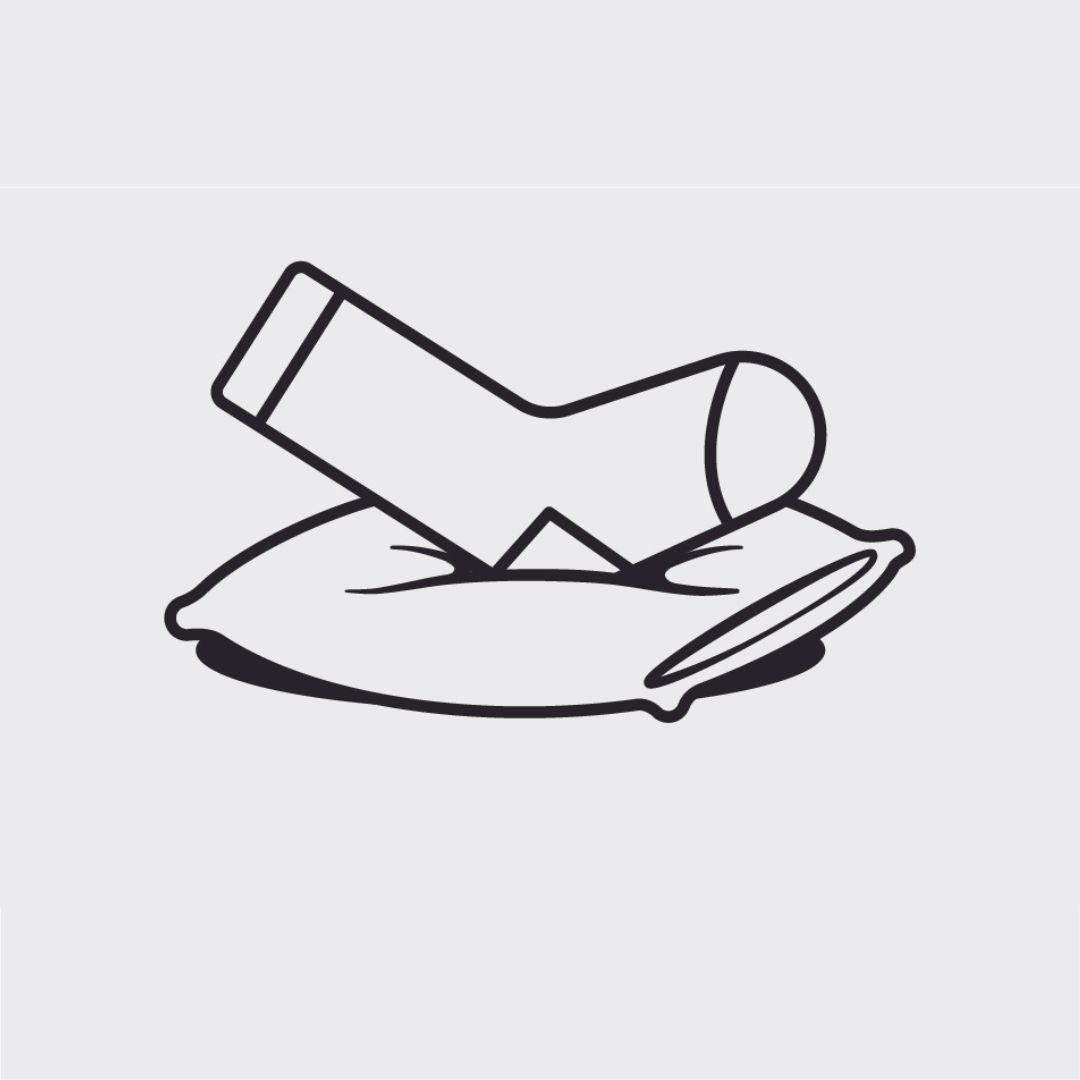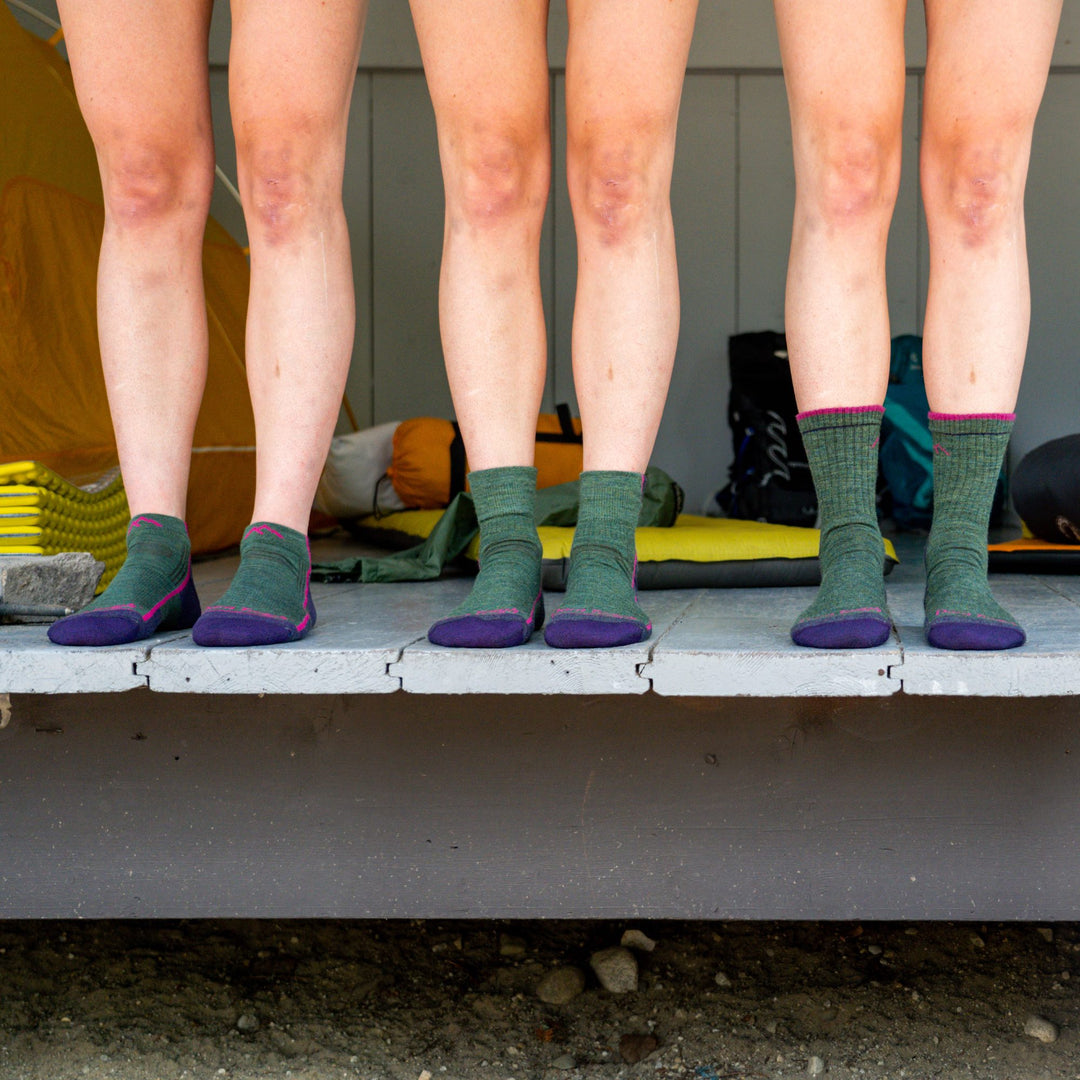Making the Most Comfortable Socks

It’s no secret. At Darn Tough, we’re committed to making the most comfortable, durable, and best fitting socks. We back that commitment with a promise – our Unconditional Lifetime Guarantee.
The first piece of that commitment is comfort. Specifically, why does comfort matter, what is comfort, and lastly, how do we make our socks so comfy we’re confident in our promise that we knit the most comfortable socks?
Why Comfort Matters
Life should be comfy. No one wants to be uncomfortable, and that’s especially true about your feet. With so much dependent on the transportation your feet provide, they deserve the best, and that means they should be comfortable.
Having comfortable feet doesn’t mean they aren’t working – but experienced athletes know the difference between the discomfort caused by long days of fitness growth versus the discomfort caused because something isn’t working.
When it comes to our feet, discomfort is something we notice fast. Comfort makes the difference between any old sock you pull out of your drawer and your favorite pair. The socks that feel so good when you slip them on, that you reach for time and time again.
At Darn Tough, we hold that we have yet to produce our best sock and are on a mission to make that happen. Dialing in comfort is a key aspect of achieving our goal.
What Is Comfort?
So, what is comfort, and how do we define a comfortable sock?

Comfort is one of those elusive topics that’s hard to measure, because it’s often personal. It’s tied to what makes you feel content and happy. When it comes to socks though, there are two key pieces that make (most) everyone happy:
- Softness
- All-day wearability
Softness
Softness is a perception, a pleasure you can feel. No one wants an itchy sock that tickles or feels like it’s rubbing and grating at their skin. Instead, comfortable socks are gentle to the touch.
All-day Wearability
You notice if your feet are uncomfortable. That feeling of too-tight shoes or the pain of a blister is hard to ignore; it draws your attention and is an increasing pest all day long.
Comfortable socks have the opposite effect. They fade into the background because they’re like a second skin. If you put a pair of Darn Tough socks on in the morning and think, “oooh these are soft!” but then never think about those socks or your feet again until they come off at the end of the day… that’s comfort, and we’ve succeeded.
How to Make Comfortable Socks

What makes Darn Tough socks so comfortable? It isn’t one choice we make – it’s many. The recipe for comfortable socks includes these ingredients:
- Soft Fibers and Yarns
- Material Structure
- Correct Fit
- Rounds of Testing and Feedback
- Extra Plush Features
Let's start at the beginning — the fibers that in turn make the yarns.
Merino Wool: A Naturally Soft Fiber
If you hear “wool” and think “itchy,” know this: Merino Wool is unlike other wool.
The reason some wools – or any other yarn and fiber – can feel itchy, prickly, or rough comes down to fiber diameter and scaling. Sounds complicated but is actually quite simple: thinner + smoother = softer.
Fiber diameter is a measure of how thick a fiber is. Different materials tend to have thinner (finer) fibers. But even within a single material type there’s some variation, like how your hair might be thicker or thinner than a sibling’s hair. Thick fibers are less pliable (bend less easily), causing that prickly feeling. When thick fibers encounter your skin, they don’t bend easily, they have less “give,” which makes them feel itchy.

Natural fibers also have scales: microscopic overlapping sections. Large scales lead to a coarser fiber, while small scales lead to smoother fibers.
You might think no scales (like synthetic fibers) would be the best… but while it’s true fibers with no scales may feel softer and smoother, you lose a lot of benefits. Scales help the fibers hold onto each other and assist in wicking away moisture. For example, human hair has little to no scale, which means it wouldn’t spin up well into a yarn. For the most comfortable socks, you want a fiber with tiny scales.
Diameter and scale are what make Merino Wool different from other wools. Merino Wool sheep produce especially fine wool fibers that have tiny, smoother scales. How fine you ask? Wool fineness is measured in microns – fewer microns = thinner wool.
Merino Wool fibers are between 15-24 microns, a super small diameter. To put that in perspective, those bulky Christmas sweaters itch because they are knit from coarser wools, probably over 30 microns. Human hair is around 75 microns. Doing the math, Merino Wool is up to 5 times thinner than your hair.
Merino’s superfine fibers bend when they meet your skin, for a soft, pleasing sensation. No itch. Just soft socks. Dang, that’s fine.
With the itch myth debunked, here’s two more reasons Merino Wool is the best material for comfy socks.
- Merino Wool is resilient. Comfortable socks stretch and move with your foot, so they don’t limit your movements. Merino fibers have a natural elasticity which lets them conform to your foot, stretch when you flex, then recover back to their original shape when you release. We build upon Merino’s natural resilience in our socks by strategically adding Lycra Spandex in high-flex areas.
- Merino Wool is naturally breathable and regulates temperature. Remember how tiny fiber scales are good because they help manage moisture? Merino fibers also have tiny crimps (like waves in hair) that can hold or release warm air, actively reacting to changes in your body temperature. Nobody wants cold toes or hot, sweaty feet, and Merino Wool socks tackle both issues head on.
The Right Knit
Having high-quality materials is only one piece of the comfort puzzle. Fibers get spun into yarns, which get turned into fabrics by processes like weaving and knitting. Fabric construction plays a key role in whether a fabric feels soft and comfortable or rough and constraining.
Turns out, if you make a woven fabric and a knitted fabric from the same exact fibers, the knitted fabric feels more comfortable. A lot of that comes back to resilience and elasticity. Comfortable clothes move with you, stretching when you stretch. Because of how it’s made, woven fabric only stretches in certain directions (grab a sheet, you’ll see what we mean) – you could say it’s a 2D fabric.
Knitting is a 3D fabric, meaning each stitch can stretch and flex in any direction. 3D stretch isn’t a must for every use case (again, woven sheets), but because of the many ways your feet move, the best fabric construction for socks is knitting.
And at Darn Tough, we don’t just knit socks. To make the most comfortable socks, we’ve mastered certain knitting techniques that up the comfort level even more. To name a few:
- Knitting in the Round: When we make socks, we aren’t taking a flat knit fabric then shaping it into the round, tubular sock shape. Instead, we knit in the round, so it’s the right shape from the get-go.
- True Seamless™: Our socks have no seams. Even the toe closure is seamless, thanks to our unique technique that’s practically imperceptible. No seams mean no seams that rub, for an uninterrupted silky sock interior.

- High-Density Knit: Sheets with a higher thread count are generally softer and better quality. The same holds true for socks. We use a high-density knit, with each square inch of our sock containing over a thousand tiny stitches, each with its own 3D stretchiness.
- Cushion: We add extra comfort to specific socks by knitting in cushion. Cushion is formed by terry loops - small yarn loops like those on a towel. These loops add a plush feel and add extra protection for your skin in high-friction areas, while also padding your footbed for a little rebound.

- Matching Stitches with Purpose: Within knitting, there are different types of stitches. These stitches provide a variety in the fabric’s appearance, but they also affect the feel. The right stitch type in the right place on the sock = next level perfection. Here’s a few examples:
- Drop needle design: This technique lets us create beautiful, intricate patterns without adding unnecessary bulk. Instead, we remove certain threads to reveal the underlying design.
- Alternate stitch: A versatile knitting technique, the alternate stitch keeps the sock’s interior nice and smooth (the opposite of a cable knit sweater). Since this stitch knits wool yarns over Lycra, using alternate stitch also increases cross stretch.
- Ribbing: Using rib knit in the cuff helps it stay in place. While traditional ribbed cuffs (used in socks like the 1466 Hiker) have a tried-and-true feel, we strategically use 1x1 rib knit in socks like our Light Hiker Micro Crew for an ultra-smooth, streamlined feel.
There’s a lot of levers you can pull when knitting – the trick is knowing which ones to pull and when. You might say we overdesign, as we put a crazy amount of thought into each stitch of a sock and what knitting technique it should use.
On the other hand, you could also say we don’t overdesign them. We have bells and whistles in our toolbox, but we don’t use them just to show we can – we use them for specific purposes, when the end-use of the sock calls for it.
Simplicity is its own form of comfort.

Performance Fit
A better fitting sock is a more comfortable sock. Just like you don’t want your hat to be too loose (blows off) or too tight (headache), your sock also needs to find that Goldilocks “just right” fit.
Since “best fitting sock” is part of our promise, we dedicated an entire post to explaining sock fit and why it matters.
Test, Test, Test
The best way to know if you’ve made a comfortable sock is to wear it. And wear it. Your sock can’t just be comfortable the first hour you have it on, or even the first day. The most comfortable socks stay that way day after day, wash after wash, so we put our socks through rigorous testing.
It’s not uncommon for us to wear a newly developed pair of socks 30 days straight, no washing. One of us even went a full 40, total flex. We know thru-hikers go days or even weeks without washing our socks; they depend on their feet day-in-day-out, and we take their trust seriously, leading us to stress-test comfort.

But we do eventually wash them. Then wash them again. Repeated cycles of washing and wearing describe the average sock life, and we test them to make sure the comfort continues cycle after cycle.
Extra Plush Features
All our socks are comfortable, and everything we’ve mentioned goes into making that comfort a reality you can count on. But if you want next-level comfort, the ultimate plush experience, a veritable spa-day for your feet, we recommend these features:

- Full Cushion: Like we said above, cushion adds extra padding and warmth to your socks using terry loops. In our Full Cushion styles, we knit terry loops into the entire sock. It’s like having your whole foot and lower leg wrapped in a Merino Wool comforter. If that sounds a bit too plush, our Cushion styles tone it down with terry loops underfoot, but not everywhere.
- Twisted Yarn: These are our softest socks. We’ve covered twisted yarn and why it’s so soft in detail elsewhere, but suffice it to say: it takes two to make a thing go right.

Don't Take Our Word for It
You could. We’ve been making (and wearing) socks for a long time. But you don’t have to, because we’re not the only ones who think our socks are darn comfortable.
"I had no idea that the wool in Darn Tough socks would be so much more comfortable than the cotton in my previous socks. I was equally surprised at how incredibly well the socks fitted my feet. I will be replacing all my old socks with these socks." — Michael R.
"These are the comfiest socks ever. Perfect amount of extra cushion to keep my feet warm in the winter, yet still not too warm. Also, I wear them when I run and I highly, highly recommend." — Jayne J.
"Wow, these are some Darn Tough and darn comfortable socks. I even wear them around the house in place of slippers." — John H.
"They're awesome. So comfortable, no seams, and always feel great even at the end of a long run!" — Nancy S.
"Darn tough socks feel so good under my feet that they make my shoes feel much better. That's right, I discovered the key to having better shoes is getting better socks." — Paul T.
"Comfiest socks ever! I’ve purchased several Darn Tough socks in various styles. Every single one of them is so comfy & well made!" — Cindy C.
Comfortable Socks: Our Promise
We believe in the comfort of our socks, and we stand behind our promise. We’re still on that journey to knitting our best sock, and your feedback is invaluable.
If these aren’t the most comfortable, durable, and best fitting socks you’ve ever worn, return them for another pair under our Unconditional Lifetime Guarantee.







